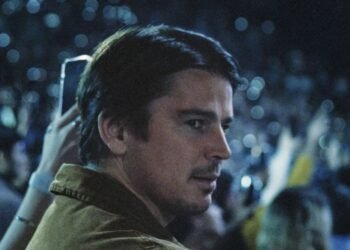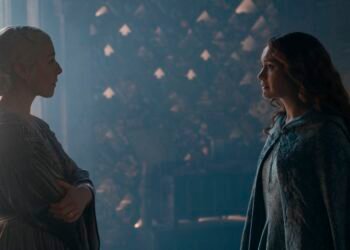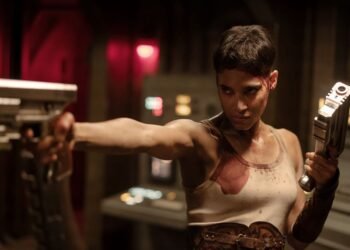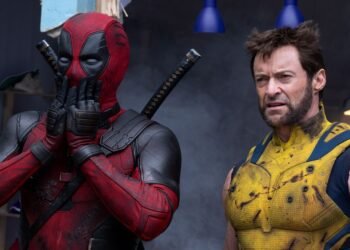Time may not be kind to Hamilton as historical fiction. Five years after the show’s Broadway debut, a filmed version of the play is hitting Disney Plus on July 3rd, a full 15 months ahead of its original scheduled theatrical release date. It’s the first time Hamilton has been widely available in any form other than its cast album. But it arrives in a world markedly different from the one where it was conceived. I saw the stage show twice myself, both times before the 2016 election, and the difference between watching it then and watching it now is palpable.
The presentation of this filmed version is occasionally rickety, but not nearly enough to stifle such a stellar production. Featuring the original Broadway cast, this recording was captured in June 2016 while the show was still a fiery sensation tearing up the Richard Rodgers Theatre on 46th Street, before it began touring and expanding to other cities.
But five years after its debut, Hamilton’s tone and portrayals clash with the current moment of mass cultural reappraisal stemming from Black Lives Matter protests. It’s a historical play about the kind of American figures whose public monuments are currently being questioned and removed from the public eye, sometimes by force.
The show’s more idealistic elements feel illusory in hindsight. It was made for a different America, and today, it’s easy to wonder whether that America ever existed at all. On its surface, the show re-casting America’s founding fathers as people of color is a fun twist aimed at re-centering who gets to tell this story. But for a show that doesn’t give the era’s slave trade more than a passing mention, the use of hip-hop as lingua franca, repackaged and sold to a mostly white and wealthy Broadway audience, feels like a gnawing paradox. That said, paradoxes are part and parcel of the show’s overarching narrative.
As a character piece, told through music and impeccable staging, Hamilton remains incredibly propulsive, and incredibly powerful. The music, lyrics, and book were written by Lin-Manuel Miranda, who takes center stage in the title role. (He’s a charming actor, though he’s hardly the best singer in the cast.) It’s certainly an unconventional adaptation of Ron Chernow’s Alexander Hamilton biography, though given Chernow’s wealth of research into Hamilton’s letters and essays, the show’s foundation is distinctly personal.

Photo: Disney Plus
And Miranda’s interpretation of the story is about a great many things. Hamilton’s rivalries with Thomas Jefferson (Daveed Diggs) and Aaron Burr (Leslie Odom Jr.) are one major thread. Another has him torn between two women who bring out the best in his head and his heart, the same way he’s torn between the warring pragmatism and idealism inherent to founding a new nation. But the core outlook that defines this fictitious Hamilton is much more intimate: his fear of death is the musical’s primary obsession.
The show’s opening number, “Alexander Hamilton,” has various characters introducing the “10-dollar founding father” in the past tense — including Burr, who famously shot and killed him in a duel. Its third track, “My Shot,” vocalizes Hamilton’s own fatalistic outlook: “I imagine death so much, it feels more like a memory.” Even as he tends to America’s future, Hamilton is plagued by ghosts of friends and fallen soldiers. The narrative often breaks for news-like interludes about how many have died on the battlefield — or in the water, as in “Right Hand Man,” during which the stage is awash in shimmering blue light, almost drowning, as characters sing solemnly about the 32,000 British troops approaching New York Harbor.
“As a kid in the Caribbean, I wished for a war,” Hamilton says, introducing us to yet another paradox. In one breath, he speaks of the death of his mother, his cousin, and many others around him in a hurricane before he moved to the mainland. In the next, he sings about how he saw war as purpose, an opportunity to rise through the ranks and prove himself. It’s as though facing death is the only way he knows how to live.
That shouldn’t deter viewers looking for a good time. There’s more than enough fun and spectacle in the show’s 160 minutes, even if the version on Disney Plus isn’t always adept at capturing its grandeur. (Or its profanity — a few swear words have been censored along the way.) You’d be hard-pressed to find a more energetic set of songs and vocal performances, even on a Disney platform, and the live audience laughing and applauding along is the next best thing in a time where live events are mostly shut down.
Most of the show is filmed at the actors’ eye level, often tracking sideways and floating in an in-between space. Except for the occasional low angle, on an entrance or post-number pose, it’s rare for the filmed Hamilton to capture actors from the audience’s vantage, whether it’s from the exorbitantly priced orchestra below, or the slightly less-exorbitant rear seats in the balcony, some 40 rows deep. During the first act, there aren’t nearly enough cuts to wide shots, which might better show off the interplay between the ensemble and the stage. (Not to mention the rest of the actors onstage at any given time.) Curiously, the wides are often chosen in moments where the focus needs to remain on singular characters, to the chagrin of anyone watching on anything smaller than a 90-inch screen.
But despite that lack of sensible cuts to wider coverage, there are far too many cuts overall, so rapid that they leave little opportunity for audiences to look around and focus on the details, or absorb the bigger picture, as they would in the theater. The few times the show cuts to an overhead angle, it doesn’t hold nearly as long as it ought to. In the center of the stage are two concentric circles which rotate during key moments — sometimes in tandem, sometimes one without the other — and in person, the choreography is kaleidoscopic. But the filmed version only offers hints of that.

Photo: Disney Plus
The mechanical spinning feels like a clock face moving ever forward, but it slows down and even reverses direction during vital scenes. Lovers pass each other like ships in the night. The trajectory of a bullet (embodied frenetically by ensemble member Ariana DeBose) becomes an extended moment of contemplation and regret as it floats through the circle, flanked by actors standing still, frozen in time. The confessional ballad “Satisfied” — sung by Hamilton’s sister-in-law Angelica Schuyler (Renée Elise Goldsberry) — rewinds the show and takes us back through the preceding scene, re-telling it from different vantages as the characters spin around, and Angelica expands on the harrowing subtext of minor interactions we’ve just seen.
Something viewers might miss in the theater is these interpersonal subtleties, like tiny worlds created between two characters, even those who only interact for a moment. The actors all certainly project for the back row, but the screen has the distinct advantage of the close-up, capturing the nuances of moments both big and small.
It’s no wonder, given the subtleties on display here, that so many cast members made the leap to film and television so seamlessly. The caricatured King George (Jonathan Groff of Mindhunter fame) is a particular delight, completing the theatrical experience with enunciated spittle, and seeming even goofier when it hangs from his chin. His closeups work the best because he’s usually the only one onstage during his three farcical solos, so the camera doesn’t often leave his gaze. That isn’t always the case for the rest of the cast.
Thomas Kail, who directed both the Broadway production and its filmed version, is clearly adept at blocking his actors, but capturing them on camera afterward proves challenging. When the stage is more crowded, he doesn’t seem to know who or what to frame, and even when he selects his targets, he doesn’t always know exactly how to frame them. Within seconds, the show cuts between two or three different angles where the simple tenets of stage left, right, and center are lost, because each camera places the performers in different parts of the frame. The effect is disorienting. It requires an extra moment of visual adjustment between cuts, and the darkened backdrop in the first half also causes all sense of physical space to be lost, until the edit returns to a wider angle. Kail might as well be cutting between rogue HD cellphone shots.
The effect worsens when characters turn to face one another, because while you’d be able to see them clearly from the seats, the cameras are often placed diagonally. On more than one occasion, they obscure their own faces when they gesticulate. The filmed presentation comes off as fairly amateur — it feels like sound and exposure levels are being adjusted on the fly, with characters initially sounding too soft or looking too washed-out when they first appear. But these problems mostly subside by the second half. After the intermission (with a helpful one-minute countdown!), the show most often centers one or two characters at a time, and the backdrop is more brightly lit, so losing the sense of space isn’t really a problem.

Photo: Disney Plus
The characters are all older and more grounded in Act II — the show spans several decades — so they don’t bounce around as wildly or wave their arms nearly as much. It’s easier to catch everything the actors do in the second half. The relationship between Hamilton and George Washington (Christopher Jackson) in particular benefits from Kail’s approach. To the orphaned Hamilton, Washington is something of a stern father figure, so his eventual departure from politics seems to reopen Hamilton’s wounds of abandonment. Their conversations play out cinematically, often in stable two-shots and over-the-shoulders, with the camera holding on both men’s close-ups.
Jackson exudes gravitas, carrying himself with grace even as his brow furrows more and more with each passing scene. But in spite of Jackson’s grounded performance, which attempts to reconcile the man and his legacy, his Washington is the only historical figure the show tries to deify. While slavery is subtly mentioned, Washington’s role in it isn’t. Thanks to the narrative framing, he’s more mythology than man, a symbol of blinkered American self-image. Much has been said about how casting mostly Black men in these parts — Washington, Jefferson, Burr, and James Madison especially — re-orients the narrative’s power dynamic, but the show is also a statement about the many ways we canonize our own history. Burr laments actions which lead him to be remembered as a villain, while Hamilton’s wife Eliza (Phillipa Soo) nurtures her husband’s posthumous legacy, which can’t help but call into question the show’s own failings in this regard.
For instance, much to-do is made about Hercules Mulligan (Okieriete Onaodowan, who also plays Madison) spying on the British government, but Mulligan’s slave Cato, who was vital to his intelligence-gathering, doesn’t so much as warrant a mention. John Laurens (Anthony Ramos) attempting to free his battalion of 3,000 enslaved soldiers comes up in context, but the fact that he died before he succeeded isn’t treated as a tragedy.
Instead, it’s an opportunity for Hamilton to get back to work, after which the battalion is never mentioned. Black and brown actors inhabit the roles of these white men and women, but there isn’t a single Black character in the show, historically speaking, so its attempts at re-centering American history on the non-white can’t help but feel half-baked — to say nothing of deifying the founding of America itself without the context of its Native inhabitants.
But while Hamilton’s relationship to history is jagged, the way the show wields its mix of fact and fiction has a raw, undeniable power. The Revolutionary War is won about a third of the way through — during the uptempo arrangement “Yorktown (The World Turned Upside Down),” a personal favourite — leaving nearly two hours during which the characters struggle with both the creation of a functioning government and their own legacies. Whatever Hamilton’s place as historical document is, its drama hits precisely.

Photo: Disney Plus
Hamilton learns of Laurens’ death through a letter from his father, during which the slain revolutionary appears as a specter to remind Hamilton how much work still needs to be done. (“Tomorrow there’ll be more of us.”) The warm wash on Hamilton and the cold spotlight on Laurens separate the worlds of the living and the dead, but the way they’re staged (and the oblique angle capturing them in the filmed version) blurs the line between them. What’s more, Laurens, who died at age 27, is played by Anthony Ramos, the same actor who plays Hamilton’s son Phillip in the second half. The double role is no doubt efficient, but it makes even the most pleasant household scenes feel burdened, portending not only Phillip’s early death — a soul-wrenching sequence where the edit, thankfully, doesn’t cut away — but Hamilton’s as well.
Even after the war, death permeates the show’s very fabric.
In spite of the characters’ fatalism, though, their outlook on the future is defined by a pragmatic mix of hope and insecurity. While the musical’s public debates over the Constitution skew far too close to Epic Rap Battles of History, Burr and Hamilton’s view of America as a concept is grounded in much more personal musings about the world they’re leaving behind for their children (“Dear Theodosia”). Seated side by side, each man is afforded lengthy, unbroken takes, as they each address their children, and the audience. “If we lay a strong enough foundation,” they sing, tapping into a mix of fear and pride, “We’ll pass it on to you, we’ll give the world to you, and you’ll blow us all away… Someday.” Hamilton occasionally idealizes history, but even though it was born of a pre-2016 era, in which idealism felt like a natural comfort for many, the show has no delusions about its present being perfect. In his dying moments, Hamilton even calls America a “great, unfinished symphony.”
Hamilton is part of that symphony — not as an answer to pressing problems, but as a question in itself: “Who Tells Your Story?” Or rather: “How is your story told?” The story America tells itself about itself is in more flux than it’s ever been, and it’s not unthinkable to see Hamilton’s occasionally rosy version of history as part of the problem. But the character dynamics it uses to tell that story are so potent that they’re emotionally overpowering. So I’d be remiss if I didn’t at least suggest letting yourself get swept up in its sentiment before processing the history underscoring it.
To have this version of Hamilton, with its original cast, at viewers’ fingertips is an opportunity to hop back in time to a moment when things seemed a little less politically dire, and introspection didn’t seem like a constant necessity. This isn’t a call to nostalgia — frankly, fuck nostalgia — but an opportunity to confront nostalgia at its rawest, and to figure out why that particular moment in time felt the way it did, even though history remains the same. Watching the show in 2020, it swept me up as it did years ago. But so much has changed in the intervening years: the political climate, my relationship to America as an immigrant, my own personal beliefs. Watching the show now puts me at war with emotions I once took for granted.
Where I once felt like I had no reason to scrutinize America’s past, I may now have more reason than ever. Picking apart your relationship to this rosy version of events might seem easy on paper, but being fully enraptured by history — not as academia, but as sentiment — could prove vital to locating and plucking one’s long-held cultural beliefs at their very root.
Pragmatic reasons aside, however, I still recommend Hamilton’s tremendous display of artistry. Miranda’s multisyllabic rhymes often echo and sample hip-hop greats like The Notorious B.I.G. Daveed Diggs is a firecracker as both Jefferson and Marquis de Lafayette. Renée Elise Goldsberry has incredible poise as Angelica, even though the character is bursting at the seams with unrequited adoration. Phillipa Soo brings devastating anguish to the role of Eliza, whose very historical erasure is re-contextualized in the show. She chooses to take herself out of the narrative, rather than being humiliated by a cheating husband who’s wrapped up in his own reputation. Through her silence alone, she salts the Earth on which he walks.

Photo: Disney Plus
And of course, no Hamilton conversation is complete without mentioning Leslie Odom Jr., who steals every scene he’s in. As the opportunistic Burr, he veers between sly and wounded, en route to a truly great villain performance. His solo “The Room Where it Happens” is an absolute showstopper. He engulfs the stage with his energy, engaging in a musical tug of war between pragmatic desires for fairer governance, and his own ambition to be the one to run things correctly. His conflict culminates in a political tête-à-tête with Hamilton — and a personal betrayal.
The filmed version of Hamilton doesn’t capture all its greatest facets, but it captures enough of them. It also captures just enough of the wooden backdrop at all times to echo the show’s many central contradictions. Adorned with ropes and staircases, the set evokes both a gallows and a shipping yard. It’s a constant reminder of the bloody history America is now contending with. But it’s also a reminder of the country’s industry and its possibilities, and it evokes how America once praised itself as a safe haven for immigrants and opportunites. The show’s most powerful moment comes not from what it captures on-camera, but from the audience in attendance, in the mid-song applause for the line “Immigrants, we get the job done.” If nothing else, that moment is a hopeful reassurance for how America might someday try to finish its symphony.
Hamilton is streaming on Disney Plus now.
























































